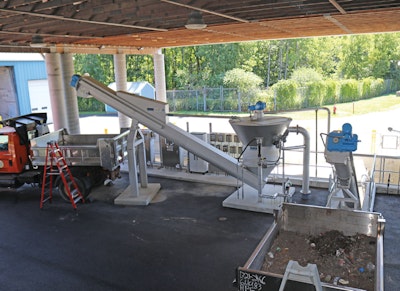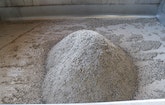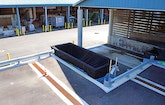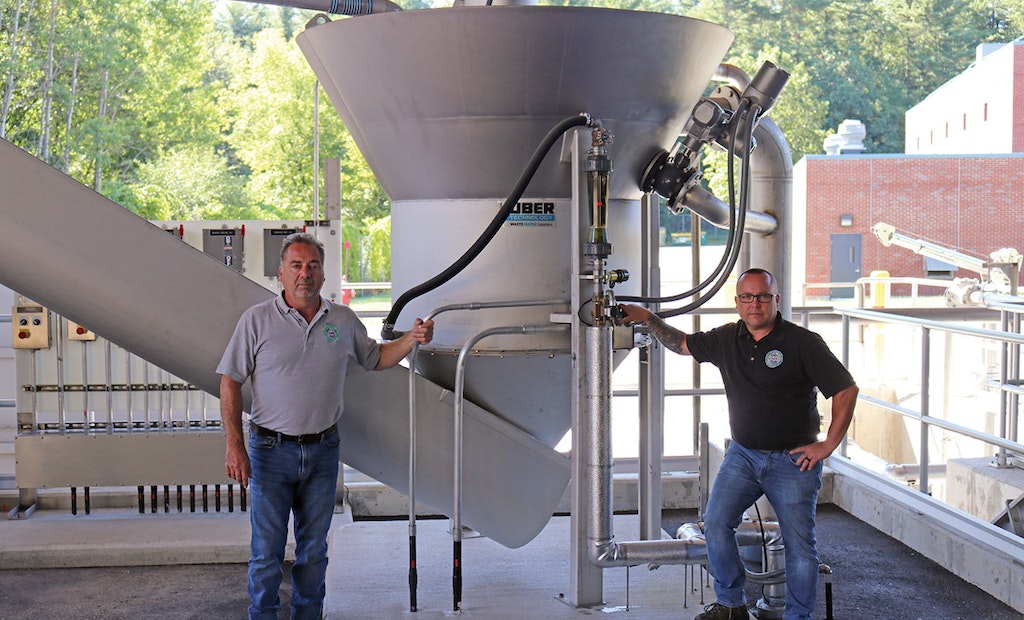Interested in Recovery/Reuse?
Get Recovery/Reuse articles, news and videos right in your inbox! Sign up now.
Recovery/Reuse + Get AlertsA wastewater treatment facility in New Hampshire is taking the streets by storm with a brand-new environmental catch basin cleanings system.
In a region where difficult winter driving conditions are routine, the City of Dover commonly uses traction sand. Until now, that sand was primarily collected in the city’s stormwater catch basins and forgotten.
Now, on the same ground as the city’s wastewater treatment plant is a new facility housing that recycles traction sand for reuse. There are three distinct operating zones: a catch basin pretreatment and storage area, an automated catch basin cleanings treatment system, and a set of dewatering boxes. The three work together to make traction sand reuse the new standard.
“We are cleaning catch basins on the stormwater side, washing that material, separating the trash out of it and making a reusable product,” says Raymond Vermette Jr., treatment facility supervisor. “We believe it’s the first catch basin street sweepings cleaning facility in the U.S.”
INSPIRATION OVERSEAS
Vermette saw a similar facility in 2009 while evaluating screw press dewatering technologies in Germany. Inspired by what he saw, and in concert with the city’s overall effort to improve sustainability and reduce disposal costs, he and city leaders decided to make a move.
The city began by hiring Wright-Pierce Engineering to help design the system. When plans were finalized, the facility was built by T-Buck Construction in an existing, partially enclosed canopy structure formerly used to store amendments for biosolids composting.
The process starts in the streets. Sweepers roam the highways, avenues, and back roads of Dover, collecting sticks, trash, sand and debris. Meanwhile, vacuum trucks empty the stormwater catch basins.
CLEANING THE LOAD
The collected assortment is brought to the sweepings facility, where it is unloaded into the pretreatment area, consisting of a sloped concrete pad, a concrete push wall, and a large trench drain. The area acts as temporary storage, allowing the material to dry via gravity before it is moved for further treatment.
Operators move the material from the pretreatment area using a JCB 505-20 telehandler loader equipped with a rock bucket. Then the cleaning process begins. The sand and debris go directly into a grit dosing screw and hopper (HUBER Technology model RoSF7, size 5).
That is followed by a wash drum (HUBER model RoSF9, size 2), which uses facility water to rinse and separate the coarse material; anything smaller than 10 mm is filtered out. A HUBER conveyor moves the debris to a hook body for hauling to landfill.
Finer solids drain from the wash drum as a slurry into a sump containing a grit pump. The pump transfers the slurry to a HUBER Coanda grit washer, where organics and contaminants are further washed from the sand. Rinsed grit is removed from the washer via screw conveyor into a second hook body.
“Our goal is obviously to reuse the washed sand as traction sand year after year,” Vermette says. “Reusing it is great, but what it’s also doing is keeping it from running into the catch basins and out into the environment.”
The larger materials like sticks, trash and rocks are also cleaned after they are separated and end up in a stainless steel hook body. The debris is eventually mixed with heavier sediment filtered out in the facility’s four dewatering boxes before going to the landfill.
SHAVING WEIGHT
Though used separately from the traction sand reuse technology, the dewatering boxes complement the facility’s effort to reduce landfill tipping fees and provide sustainable practices. Park Process GeoCat dewatering boxes used for sewer jetting waste and wet well cleanings sit at the end of a drive-up ramp large enough to fit two vacuum trucks at the same time.
“When the vacuum trucks come in with the wet-well cleanings, it can be heavy with sediment and water,” Vermette says. “By dewatering, the goal is to minimize what’s going to the landfill. We are saving on tonnage fees and conserving more water by putting it through treatment and back into use.”
Through a series of trench drains and pumps, the separated water is moved to the head of the treatment plant. The leftover debris is eventually brought to the landfill, weighing significantly less than when saturated with water.
“We’re actually taking the trash from the street sweepings and catch basin cleaning, which is on the lighter side, and putting that in with the heavier dewatering debris to get a full box while maintaining the right weight for travel,” Vermette says.
GAINING TRACTION
The sweepings facility began operation in 2021, and about 60 cubic yards of sand was recovered, cleaned and stored for reuse, Vermette is certain that amount will only go up: “The volume of grit-laden street waste from the city’s 3,200 catch basins and hundreds of miles of streets has increased over the years. This is still all new, so we are working the bumps out of it.”
He also believes efforts like Dover’s will gain popularity with communities across the country as regulations tighten over time. The city is regulated as part of the U.S. EPA’s Municipal Separate Storm Sewer System General Permit Program, also known as MS4, which requires routine cleaning of catch basins to ensure that they are never more than 50% full of debris.
“Our goal is to sustainably process and remove that waste as part of the city’s MS4 compliance efforts,” Vermette says. “I think more cities will begin to realize the sustainability of these methods while complying with the regulations.” Developing the sweepings facility took time and determination, but for Vermette and his team, the outcome has been well worth the effort.









